|
The Genus Laetiporus 
[ Basidiomycota > Polyporales > Laetiporaceae . . . ]
by Michael Kuo
The genus Laetiporus holds a relatively small group of soft-fleshed polypores that lack stems and, in all but one species and one variety, demonstrate bright orange to yellow colors. Most of the species, together, are commonly referred to as "chicken of the woods" mushrooms, and they cause a brown rot of the wood of both conifers and hardwoods (depending on the species). They are parasites and saprobes, apparently able to play either ecological role.
Identification of Laetiporus species and varieties in North America is not particularly difficult, and can usually be accomplished by careful observation of the ecology, location, and physical features of the mushrooms. The North American species appear to have limited distribution (in North America, at least; some of the species also occur elsewhere) and host preferences: some species are limited to the wood of conifers, while others appear on the wood of hardwoods. Since the deadwood is often a fallen log, collectors may need the ability to recognize dead conifers (which usually feature a whorled branching pattern and straight trunks) and dead hardwoods (which do not have whorled branches and often feature branching trunks).
Physical features important for identification of Laetiporus species include the color of the cap surface and the pore surface, and the general habit of the fruiting bodies: some species are "butt rot" species that occur in rosettes at the bases of trees, while others are heart rot species that usually occur in shelving clusters above the ground (or sometimes in rosettes when growing on the tops of fallen logs).
Microscopic features are generally similar for most North American species of Laetiporus, which all have inamyloid, ellipsoid spores and dimitic, clampless hyphal systems. Laetiporus cincinnatus has small spores and can be separated from confusing Laetiporus sulphureus specimens with reference to spore size, but microscopic analysis is generally not required for Laetiporus identification.
As of this writing the most current DNA studies place the sulphureus-like species of Laetiporus (meaning: all of the North American species except Laetiporus persicinus) together in a group that will probably be called Laetiporus—once the official representative ("type") species, Laetiporus sulphureus, is defined in contemporary terms (see the discussion on the linked page). Laetiporus persicinus, however, turns out to be more closely related to Phaeolus schweinitzii than to the sulphureus group—and species of Wolfiporia (don't ask) are also part of the picture that is only beginning to approach resolution. Most recently, a sweeping study of the polypores by Justo and collaborators (2017) places Laetiporus, Wolfiporia, and Phaeolus together in a family called the Laetiporaceae, but the authors caution that "[t]he delimitation of Laetiporus vs. Wolfiporia needs further study."
|
|
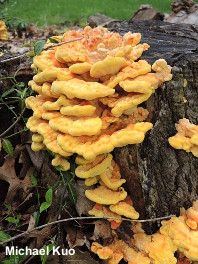
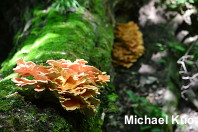
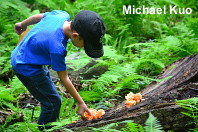
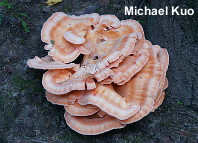
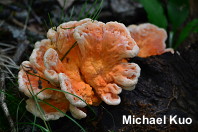
|
Key to 7 Laetiporus species and varieties in North America 
| 1. | Caps brown with a white edge; pore surface bruising promptly and strongly brown; distributed in the southeastern United States and the Caribbean. | Laetiporus persicinus |
| 1. | Caps a shade of orange or yellow; pore surface not bruising strongly brown; variously distributed. | 2 |
| 2. | Growing on the wood of conifers. | 3 |
| 2. | Growing on the wood of hardwoods. | 4 |
| 3. | Distributed in the northern Midwest and the northeastern United States. | Laetiporus huroniensis |
| 3. | Distributed from the Rocky Mountains westward. | Laetiporus conifericola |
| 4. | Pore surface white to cream-colored. | 5 |
| 5. | Growing in rosettes at the bases of oaks (very rarely in shelving clusters off the ground but then generally with ground-based rosettes nearby); cap surfaces generally peachy orange to orange or reddish orange, without prominent yellow shades; widely distributed from the Great Plains eastward; most spores less than 5.5 µm long. | |
| 5. | Growing in shelving clusters above ground (rarely in rosettes, but if so then on the tops of fallen logs); cap surfaces yellow-orange to yellow—or very pale pinkish orange to whitish; variously distributed; spores variously sized. | 6 |
| 6. | Cap surface pale pinkish orange to almost white; fairly common on the deadwood of oaks or eucalyptus in the Gulf states and the Caribbean. | Laetiporus gilbertsonii
var. pallidus |
| 6. | Cap surface yellowish orange to yellow; rare; ecology and distribution poorly documented. | |
| 7. | Growing on the wood of eucalyptus or oaks on the West Coast and in Mexico (and reported from Arizona and Texas). | |
| 7. | Growing on the wood of oaks from the Great Plains eastward. | |
References
Banik, M. T. & H. H. Burdsall (1999). Incompatibility between Laetiporus cincinnatus and L. sulphureus in culture. Mycotaxon 70: 461–469.
Banik, M. T. & H. H. Burdsall (2000). Incompatibility groups among North American populations of Laetiporus sulphureus sensu lato. Mycologia 92: 649–655.
Banik, M. T., D. L. Lindner, Y. Ota & T. Hattori (2010). Relationships among North American and Japanese Laetiporus isolates inferred from molecular phylogenies and single-spore incompatibility reactions. Mycologia 102: 911–917.
Burdsall, H. H. Jr. & Banik, M. T. (2001). The genus Laetiporus in North America. Harvard Papers in Botany 6: 43–55..
Gilbertson, R. L. & Ryvarden, L. (1986). North American polypores. Vol. 1. Oslo: Fungiflora.
Ginns, J. (2017). Polypores of British Columbia (Fungi: Basidiomycota). Province of British Columbia, Victoria, British Columbia. Technical Report 104. 260 pp.
Justo, A., O. Miettinen, D. Floudas, B. Ortiz-Santana, E. Skökvist, D. Lindner, K. Nakasone, T. Niemelä, K. -H. Larsson, L. Ryvarden & D. S. Hibbett (2017). A revised family-level classification of the Polyporales (Basidiomycota). Fungal Biology 121: 798–824.
Lindner, D. & M. T. Banik (2008). Molecular phylogeny of Laetiporus and other brown rot polypore genera in North America. Mycologia 100: 417–430.
Overholts, L. O. (1953). The Polyporaceae of the United States, Alaska and Canada. Ann Arbor: University of Michigan Press. 466 pp.
Song, J. & B. -K. Cui (2017). Phylogeny, divergence time and historical biogeography of Laetiporus (Basidiomycota, Polyporales). BMC Evolutionary Biology 17: 102.
Tomŝovský, M. & L. Jankovský (2008). Validation and typification of Laetiporus montanus. Mycotaxon 106: 289-295.
This site contains no information about the edibility or toxicity of mushrooms.
Cite this page as:
Kuo, M. (2017, November). The genus Laetiporus. Retrieved from the MushroomExpert.Com Web site: http://www.mushroomexpert.com/laetiporus.html
© MushroomExpert.Com
|





